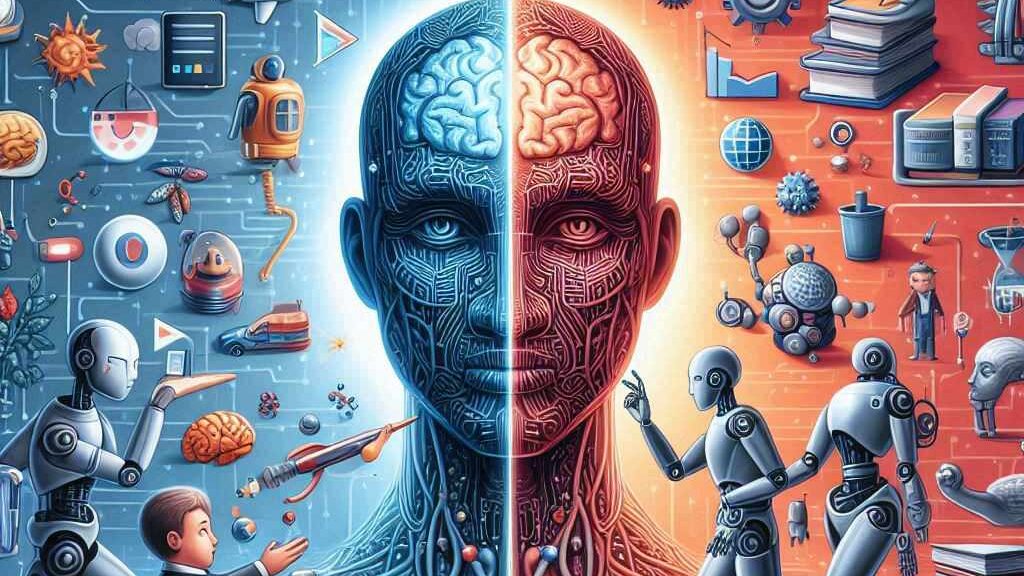A branch of artificial intelligence known as "generative artificial intelligence" (Gen AI) is concerned with employing machine learning algorithms to produce new material, including writing, photos, music, and other media types. Generative AI can create new data comparable to the data it was trained on, unlike traditional AI, which is frequently built to identify patterns and make judgements based on existing data.
"Gen AI" and "General AI," also known as "Artificial General Intelligence (AGI)," refers to a type of artificial intelligence that can understand, learn, and apply knowledge across a wide range of tasks at a level equal to or beyond that of a human being.

Gen AI encompasses the following key characteristics and applications:
- Natural Language Processing (NLP): Gen AI can generate coherent and contextually relevant text, such as articles, conversational responses, and translations.
- A few examples are listed below:
- Medical Field:
- Clinical Documentation: NLP healthcare systems help to free clinicians from the laborious physical systems of Electronic Health Records (EHRs) and allow them to invest more time in the patient.
- Speech Recognition: NLP is utilised in healthcare for tasks such as speech-to-text dictation and structured data entry.
- Data Mining Research: NLP techniques translate raw text data into valuable insights across various areas in healthcare.
- Financial Sector:
- Risk Assessments: Banks can use credit risk assessments to measure the probability of a successful loan payment.
- Accounting and Auditing: NLP is applied in the financial sector for auditing and accounting purposes.
- Portfolio Selection and Optimisation: NLP and Machine Learning techniques are utilised for portfolio selection and optimisation.
- Defence Mechanisms:
- Adversarial Attacks and Defenses: Adversarial attacks and defences are a significant concern for NLP models. These attacks involve subtly manipulating inputs to change the model's behaviour. Defence mechanisms include adversarial training, input pre-processing techniques, and model interpretability methods.
- Textual Manifold-based Defense (TMD): One specific defence mechanism is Textual Manifold-based Defense (TMD), which involves learning the embedding space manifold of the underlying language model and projecting new inputs back to the approximated structure before classification.
- Securing Models Against Malicious Inputs: NLP models are also secured against malicious inputs. This includes using gradient-based approaches that exploit the model's gradients to generate adversarial examples.
- Image Generation: This involves creating new images from scratch or modifying existing ones. Examples include creating artwork, designing new products, and enhancing photographs.
- NLP is utilised in a wide range of applications, including image generation.
- Text-to-Image Synthesis: This process involves a system generating images from textual descriptions. For instance, inputting "a red bird with a short beak" will prompt the system to create a corresponding picture. Achieved through training a model on a large dataset of images and their textual descriptions, the model learns to correlate text with image features. Popular models for this task include the Generative Adversarial Network (GAN), specifically designed for this purpose, such as the StackGAN.
- Image Captioning is the reverse process of text-to-image synthesis. Here, the system generates a textual description of an image by understanding its content and identifying objects, attributes, and relations. This involves using Convolutional Neural Networks (CNNs) for feature extraction from the image and Recurrent Neural Networks (RNNs) or Transformers to generate the textual description.
- Interactive Image Editing: NLP interprets user commands in natural language to edit images in this application. For example, if a user says, "Change the colour of the car to blue," the system edits the image by understanding the command, identifying the relevant object, and applying the appropriate image editing operation.
- These examples showcase combining NLP with image processing techniques to create systems capable of understanding and generating images based on textual descriptions. These techniques have broad applications, from creating art to aiding visually impaired individuals in understanding the visual world.
- NLP is utilised in a wide range of applications, including image generation.
- Music and Audio: Gen AI can compose music, create sound effects, and even mimic the voices of specific individuals.
- A few instances of NLP utilised in the realm of music and audio are as follows:
- Composer Classification: Researchers have used NLP-based techniques for music processing to classify music pieces by composer. They utilised musical data from the MIDI, audio editing for synchronous tracks, and organised datasets of virtuosic piano pieces. The goal was to represent a musical piece using SentencePiece and Word2vec, which are NLP-based techniques.
- Symbolic Music Generation and Information Retrieval: NLP methods have also been applied to symbolic music generation and information retrieval. This includes using Transformer models, initially developed for NLP, in Music Information Retrieval (MIR). These models process music data and leverage the sequential representations shared by text and music.
- AI Music Systems: AI music systems like OpenAI's Jukebox use NLP to generate audio. These systems can continue playing a song based on a snippet, demonstrating the power of NLP in understanding and developing music.
- A few instances of NLP utilised in the realm of music and audio are as follows:
- Video and Animation: Gen AI can generate new video content, animate characters, and create special effects.
- Examples of how NLP is utilised in the video and animation industry:
- Video Transcription: NLP can transcribe video audio into text, making it helpful in creating subtitles or closed captions to reach a broader audience.
- Content Analysis and Recommendation: Natural Language Processing (NLP) involves advanced spoken or written language analysis to detect and understand the specific subjects and ideas being communicated. This in-depth analysis provides valuable data that can be utilised to categorise videos, thereby enhancing users' search capabilities. Additionally, this data can give personalised video recommendations, improving overall user experience and engagement.
- Interactive Videos: NLP can create interactive videos in which the storyline changes based on the viewer's natural language input. This creates a more engaging and personalised viewing experience. These are just a few examples, and the applications of NLP in video and animation are continually expanding with technological advancements.
- Examples of how NLP is utilised in the video and animation industry:
- Data Augmentation: In machine learning, generative AI can create synthetic data to enhance training datasets, thereby improving model performance through a more diverse set of examples.
- Discover the power of NLP in enhancing data through augmentation:
- Synonym Replacement: This technique involves replacing words in the text with their synonyms to create a new sentence with the same meaning. This method is part of a broader set of techniques known as Easy Data Augmentation (EDA) operations, which also include word insertion, word swap, and word deletion.
- Back Translation is a widely used technique in natural language processing (NLP) to expand text data. It works by translating text from the original language into a target language and then translating it back into the original language. This helps introduce small variations in the wording and sentence structure, thus enhancing the diversity of the training data.
- Text Generation: NLP can create new text samples that resemble existing data. For example, a text generation method has been developed to enhance the performance of classifiers for long and short texts. This method has shown promising improvements, particularly in small data analytics.
- These techniques help enhance the diversity of the training data, thus enabling the model to better generalise to unseen testing data.
- Discover the power of NLP in enhancing data through augmentation:
- Personalisation and Recommendations: By understanding user preferences, generative AI can create personalised content and recommendations, enhancing user experience in applications like online shopping, entertainment, and social media.
- NLP applies various methodologies to extract valuable data from textual sources.
- These techniques include Sentiment Analysis, which involves identifying and categorising sentiments expressed in the text;
- Named Entity Recognition, which identifies and classifies entities such as names of people, organisations, and locations within the text;
- and Summarization, which condenses the main points or critical information within the text;
- Topic Modelling, which identifies common themes or topics within the text;
- Text Classification, which categorises the text into predefined classes or categories;
- Keyword Extraction, which identifies and extracts essential words or phrases from the text;
- and Lemmatization and Stemming, which involves reducing words to their base or root form to simplify analysis and interpretation.
- NLP applies various methodologies to extract valuable data from textual sources.
- Examples of how NLP is used in personalisation and recommendations:
- Voice Assistants: Siri, Alexa, and others employ natural language processing to interpret and respond to human orders. They can provide tailored suggestions based on a user's previous interactions and preferences.
- E-commerce and Streaming Platforms: Amazon and Netflix use NLP in their recommendation algorithms. They recommend customised content to individuals based on their surfing history, interests, and behaviour. This not only increases user engagement, but also boosts revenue and customer happiness.
- Social Media Platforms: Facebook and Twitter employ natural language processing (NLP) to examine user-generated material. They utilise this research to give customers tailored suggestions and adverts.
- Medical Field:
- A few examples are listed below:
These instances show how NLP may improve suggestions and customisation while enhancing user experience and engagement.
Prominent examples of generative AI models include GPT (Generative Pre-trained Transformer) for text generation, DALL-E for image creation, and other models for music composition and video generation tasks.

Tasks Where Humans Excel
Whether human performance surpasses that of General AI (Gen AI) without its assistance is contingent upon the specific tasks and context in question. The following analysis presents a comparison of human capabilities and those of Gen AI across a variety of domains:
- Emotional Intelligence and Empathy:
- Humans often better facilitate comprehension and response to intricate emotional and social cues.
- Counselling, therapy, and negotiations commonly benefit from a personal touch.
- Creative Thinking:
- AI can generate material, but people excel at developing unique ideas, art, and stories.
- Humans excel at complex creative processes that involve deep comprehension and subtle expression.
- Ethical Decision Making:
- When facing ethical and moral challenges, individuals can effectively navigate them by considering their cultural, social, and personal values.
- In situations where important ethical decisions need to be made, human judgment proves beneficial.
- Complex Problem Solving with Limited Data:
- Humans are adept at making decisions with incomplete information and quickly adapting to new situations.
- Critical thinking and problem-solving are strengths in dynamic and uncertain environments.
Tasks Where Gen AI Excels

- Data Analysis and Pattern Recognition:
- AI can analyse large amounts of data rapidly and accurately, uncovering patterns that may elude humans.
- Tasks such as extensive data analysis, medical imaging, and financial modelling benefit from AI's capabilities.
- Automation of Repetitive Tasks:
- AI can efficiently handle repetitive and mundane tasks without fatigue.
- Automated manufacturing, data entry, and customer service processes enhance productivity and reduce errors.
- Speed and Scalability:
- Gen AI can process information and generate outputs at a speed and scale that is impossible for humans.
- AI outperforms humans in real-time language translation, large-scale simulations, and extensive data mining.
- AI in terms of consistency and accuracy:
- AI systems deliver reliable results that are void of human error or bias.
- AI guarantees high precision in quality control, standardised testing, and routine medical diagnostics.
Collaborative Potential
Collaboration between humans and AI frequently produces the finest results.
For example:
- Medical Field: AI can assist doctors by providing diagnostic suggestions based on large datasets, while doctors bring their experience and judgment to make final decisions.
- Creative Industries: AI tools can enhance human creativity by providing new ideas or automating certain aspects of the creative process, allowing humans to focus on innovation and expression.
- Business: AI can handle data-driven insights and predictions, while human managers use this information to make strategic decisions.
Although Gen AI offers significant advantages in specific areas, human input remains invaluable due to our unique strengths. By combining our strengths, we can develop more effective and innovative solutions across various fields.
Ethical Concerns
In discussions on generative artificial intelligence (Gen AI), several ethical, social, and technological factors are under consideration. The following highlights some of the main areas of disagreement:
Bias and Fairness
- Issue: AI models may perpetuate biases in training data, leading to unfair outcomes.
- Debate: How can we ensure that AI systems are fair and unbiased? What measures should be implemented to detect and mitigate bias?
Privacy
- Issue: AI systems often require substantial amounts of data, including sensitive personal information.
- Debate: How can we safeguard individual privacy while leveraging the potential of Gen AI? What are the optimal methods for data anonymisation and consent?
Autonomy and Control
- Issue: As AI systems become more advanced, there is concern about losing human control over these systems.
- Debate: How can we ensure human oversight and accountability for AI decisions? What safeguards are needed to prevent harmful autonomous AI actions?
Societal Impacts
Job Displacement
- Issue: Automation and AI can potentially replace workers in specific industries, which could lead to economic disruption.
- Debate: How should society address the potential job losses? Which policies and programs are needed to support displaced workers and ensure economic stability?
Social Manipulation
- Issue: Gen AI is capable of generating convincing fake content (deep fakes) that can be used to spread misinformation or manipulate.
- Debate: How can we detect and prevent the spread of fake content? What are the ethical implications of using AI for content creation?
Technical Considerations
Transparency and Explainability
- Issue: Many AI models operate as "black boxes," making it difficult to understand their decision-making process.
- Debate: How can we increase the transparency and explainability of AI systems? What trade-offs exist between model complexity and interpretability?
Safety and reliability

- Issue: Ensuring the safety and reliability of AI systems is essential, particularly in critical applications such as healthcare or autonomous vehicles.
- Debate: What standards and testing procedures are essential to ensure the safety and reliability of AI systems? How can we construct resilient systems capable of handling unexpected situations?
Regulatory and Legal Issues
Accountability
- Issue: Determining who is responsible when an AI system causes harm or makes a mistake.
- Debate: How should liability be assigned in cases involving AI? What legal frameworks are necessary to address the unique challenges presented by AI?
Intellectual property
- Issue: The development of new content by AI raises concerns about intellectual property rights.
- Debate: Who owns the content generated by AI? How should intellectual property laws be updated to reflect the capabilities of Gen AI?
Research and Development
Open Access vs. Proprietary Models
- Issue: The balance between open-access research, which can accelerate innovation, and proprietary models that provide financial incentives for development.
- Debate: Should AI research primarily be open to promote transparency and collaboration, or should there be more emphasis on protecting intellectual property to incentivise investment?
Resource Allocation
- Issue: Harnessing the potential of advanced AI models often demands substantial computational resources, which may serve as a barrier to entry for less well-funded entities.
- Debate: How can we ensure equal access to AI development resources? What is the role of governments and public institutions in supporting AI research?
The discussion surrounding Generative AI is complex and diverse, involving various stakeholders such as researchers, legislators, industry executives, and the general public. Addressing these challenges requires a collaborative, multidisciplinary approach that combines innovation with ethical and societal considerations.
Individuals' effectiveness without the assistance of Gen AI largely relies on the particular context and format of the task at hand. Some situations may be enhanced by human intuition, creativity, and emotional intelligence, whereas others may necessitate the data processing, analytical capabilities, and efficiency of Gen AI.
- Prasanna Abeysekera
The effectiveness of individuals without Gen AI assistance can vary greatly depending on the context and format of the task.
Here are some examples:
- Human Intuition and Creativity: Human intuition and creativity are essential in tasks that require a high degree of creativity, such as writing a novel, composing music, or creating art. These tasks involve abstract thinking, emotional depth, and a nuanced understanding of human experience, which are areas where humans currently outperform AI.
- Emotional Intelligence: Humans such as therapists, social workers, and customer service representatives are adept at tasks that require understanding and responding to human emotions. They can pick up on subtle emotional cues and respond with empathy, a skill that AI systems are still learning.
- Data Processing and Analysis: Tasks involving processing large amounts of data, performing complex calculations, or analysing patterns across vast datasets are areas where General AI can be highly effective. For instance, in fields such as finance, logistics, or meteorology, AI can process and analyse data much more quickly and accurately than a human can.
- Efficiency: AI is well-suited to repetitive, mundane, or exact tasks. These include assembly line work, data entry, and quality control inspections. AI can perform these tasks tirelessly and consistently, often with fewer errors than humans.
The effectiveness of individuals without the assistance of General AI depends heavily on the nature of the task. Humans excel in areas that require creativity, intuition, and emotional understanding, while AI is highly effective in tasks that involve data processing, analysis, and efficiency. The key is to find the right balance and integration between human skills and AI capabilities.

The complexity level of the task
The complexity of achieving advanced human-AI collaboration, where AI can potentially replicate or augment unique human strengths, involves multiple dimensions, including technological, ethical, social, and interdisciplinary challenges.
Here is an elaboration on the complexity of this task:
Technological Challenges
- Advanced Machine Learning and AI Algorithms:
- Developing AI algorithms that can imitate human-like reasoning, decision-making, and creativity requires advances in machine learning and artificial neural networks.
- Creating AI that can continuously learn and adapt to new situations without extensive retraining is a significant challenge.
- Computing Power and Infrastructure:
- The development of advanced AI requires immense computational resources. High-performance computing and quantum computing could be crucial in overcoming these limitations.
- It is necessary to process and analyse vast amounts of data to train sophisticated AI models.
- Human-Like Adaptability and Flexibility:
- AI systems must address unforeseen challenges with the same flexibility and creativity as humans.
- Developing AI that can incorporate context, culture, and human experiences into decision-making adds another layer of complexity.
Ethical and Social Challenges
- Ethical AI Development:
- Ethical guidelines and frameworks for AI development are crucial to ensure transparency, accountability, and fairness.
- Addressing potential biases in AI systems is essential to prevent the perpetuation or exacerbation of existing inequalities.
- Societal impact:
- The societal impact of AI must be carefully managed, considering job displacement, privacy concerns, and the potential for AI to be used in harmful ways.
- Engaging with society to address problems and promote understanding and acceptance of AI technologies is essential.
Interdisciplinary Research and Collaboration
- Neuroscience and Cognitive Science:
- Insights from neuroscience and cognitive science are essential for developing AI that can comprehend and replicate human mental processes.
- Brain-computer interfaces (BCIs) and other technologies bridge the gap between human cognition and machine processing.
- Psychology and Social Sciences:
- Understanding human behaviour, emotions, and social dynamics is crucial for developing AI that can effectively and empathetically interact with humans.
- Collaboration between AI researchers, psychologists, and social scientists is vital.
Implementation and Integration
- Human-in-the-Loop Systems:
- Developing AI systems with human input and oversight as integral to AI's functioning, ensuring human strengths complement AI capabilities.
- Creating mechanisms for continuous human feedback to improve and refine AI systems.
- Real-World Applications and Case Studies:
- Applying AI in real-world scenarios to test and refine its capabilities and address shortcomings.
- Learning from specific case studies in healthcare, finance, and creative arts industries.
Continuous Learning and Adaptation
- Lifelong Learning Systems:
- Creating AI systems capable of continuous learning and adaptation, similar to human lifelong learning.
- Implementing mechanisms for AI to acquire new knowledge and skills autonomously.
- Human-Like Decision Making:
- Developing AI to make decisions in complex, evolving environments with limited data.
- Ensuring AI can comprehend and navigate ethical and moral challenges.
Policy and Regulation
- Regulatory Frameworks:
- Establishment of regulatory frameworks governing the development and deployment of AI technologies.
- Ensuring compliance with laws and regulations related to data privacy, security, and ethical standards.
- Global Cooperation:
- Promoting international cooperation to address the global implications of AI technology.
- Sharing best practices and collaborating on AI research and development.
Replicating or enhancing human strengths with AI involves navigating a complex terrain of technological, ethical, social, and interdisciplinary considerations. Accomplishing this objective calls for a comprehensive approach, integrating advancements in AI technology with thoughtful examination of moral and societal consequences, collaboration across different fields, and ongoing adaptation and learning. While it presents challenges, the potential advantages of these advancements are substantial, offering to improve human abilities and generate new prospects for innovation and development.

The accessibility of resources and knowledge
A diverse array of resources and expertise is essential to advancing AI technologies, particularly in the realm of replicating or enhancing unique human capabilities. Below lies an exhaustive analysis of the diverse resources and expertise essential for undertaking this intricate assignment:
Technological Resources
- High-Performance Computing (HPC)
- Requirement: Advanced AI models require significant computational power for training and inference.
- Availability: Cloud computing platforms like AWS, Google Cloud, and Microsoft Azure provide scalable HPC resources. Research institutions also offer dedicated supercomputing facilities.
- Data Storage and Management
- Requirement: Storing massive datasets for training AI models requires reliable storage solutions.
- Availability: Distributed storage systems, data lakes, and databases (e.g., Hadoop and Apache Spark) are widely available and continue to evolve.
- Quantum Computing
Data Resources
- Datasets
- Requirement: Large, diverse, high-quality datasets are essential for AI model training.
- Availability: Public datasets (e.g., ImageNet, Common Crawl, UCI Machine Learning Repository) are available alongside proprietary datasets owned by organisations.
- Data Privacy and Ethics
- Requirement: Ensuring data privacy and ethical use of data is crucial.
- Availability: Frameworks and tools for data anonymisation and privacy-preserving techniques (e.g., differential privacy) are increasingly available.
Human Expertise
- AI and Machine Learning Researchers
- Requirement: Seeking AI, machine learning, and deep learning experts to develop and refine algorithms.
- Availability: Top universities and research institutions worldwide continuously produce AI experts. Leading researchers are employed by companies such as Google, Facebook, and OpenAI.
- Domain Experts
- Requirement: Domain-specific knowledge needs to be provided by professionals with expertise in specific fields (such as healthcare, finance, and law).
- Availability: Collaboration between AI researchers and domain experts from industry and academia is widespread.
- Neuroscientists and Cognitive Scientists
- Requirement: Studying human cognition to develop AI that can replicate human thinking.
- Availability: Leading research institutions and interdisciplinary centres emphasise the fusion of AI and cognitive science.
- Ethicists and Social Scientists
- Requirement: Ensuring ethical AI development while also comprehending its social repercussions.
- Availability: There is a growing interest and competence in AI ethics, with specific programmes and research facilities like the Alan Turing Institute and the MIT Media Lab.
Interdisciplinary Collaboration
- Cross-Disciplinary Research Centers
- Requirement: Facilities that promote collaboration among AI researchers, domain experts, and ethicists.
- Availability: Many universities and research institutes have established interdisciplinary centres, such as the Stanford Human-Centered AI Institute and the Berkeley AI Research Lab.
- Industry-Academia Partnerships
- Requirement: Industrial and academic institutions engage in collaborative projects and research endeavours.
- Availability: Partnerships with entities such as the Microsoft Research Lab, Google AI, and universities are widespread.
Financial Resources
- Funding and Investment
- Requirement: Substantial funding is required to develop and implement sophisticated AI technologies.
- Availability: Government grants, private sector investment, venture capital, and philanthropic funding are crucial funding sources. Organisations such as DARPA, the European Commission, and private investors extensively fund AI research.
- Public and Private Sector Support
- Requirements: Public and commercial sector support for long-term AI development.
- Availability: Both public initiatives (such as government AI strategy plans) and private sector investment (such as company R&D financing) are on the rise.
Infrastructure and Tools
- AI Development Platforms
- Requirement: Discover the essential tools and platforms for developing, testing, and deploying AI models.
- Availability: Open-source platforms such as TensorFlow and PyTorch, along with proprietary tools and cloud-based AI services, are widely used.
- Regulatory and Ethical Frameworks
- Requirement: Guidelines and regulations are imperative to ensure the ethical development and deployment of artificial intelligence (AI).
- Availability: National and international organisations, such as the OECD AI Principles and the EU AI Act, are developing frameworks, while bodies like IEEE and ISO are working on standards.
Resources and knowledge are abundant and constantly expanding for the advancement of AI to duplicate or enhance human qualities. Nevertheless, coordinating efforts across several disciplines and sectors is necessary to leverage these resources successfully. Interdisciplinary cooperation, ethical concerns, and ongoing investments in human and technological resources are crucial to successfully navigate the intricacies of this undertaking.
The Difficulties of Creating Advanced AI Under Time Restraints
Developing AI that can replicate or augment unique human strengths is a highly ambitious goal bound by significant time constraints. These constraints stem from several factors, including technological development, regulatory processes, ethical considerations, and the need for continuous adaptation.
Here is an elaboration on the critical time-related challenges:
Technological Development Timeline
- Research and Development (R&D)
- Requirement: Fundamental research in AI, machine learning, and related fields to develop new algorithms and models.
- Time Constraint: It often takes decades for cutting-edge research to advance from theoretical concepts to practical applications.
- Data Collection and Processing
- Requirement: The acquisition and processing of extensive, high-quality datasets to train artificial intelligence models.
- Time Constraint: Collecting enough data, ensuring it's high quality, and preparing it for AI training takes a lot of time.
- Training AI Models
- Requirement: Deep learning model training takes much time and processing power, especially for large-scale models.
- Time Constraint: Training advanced AI models can take weeks or months, depending on their complexity and size.
- Testing and validation
- Requirement: Rigorous testing and validation of AI systems are essential to ensure their reliability, accuracy, and safety.
- Time Constraint: Comprehensive testing phases, including real-world trials, may lead to significant delays in deployment.
Regulatory and Ethical Processes
- Ethical Approval and Compliance
- Requirement: Ensuring that AI systems comply with ethical standards and regulations.
- Time Constraint: Getting ethical approval and ensuring compliance with regulations can be lengthy, involving reviews and potential revisions.
- Regulatory Approval
- Requirement: Obtaining regulatory approval for AI applications, particularly in sensitive sectors such as healthcare and finance.
- Time Constraint: Regulatory review processes can be lengthy and involve thorough checks and requirements for documentation and evidence.
Interdisciplinary Collaboration
- Coordinating Across Disciplines
- Requirement: Cooperation among AI researchers, domain experts, ethicists, and policymakers is paramount.
- Time Constraint: Effective interdisciplinary collaboration requires time to establish common goals, methodologies, and communication channels.
- Knowledge Integration
- Requirement: Integrating insights from neuroscience, psychology, cognitive science, and other fields into the development of AI.
- Time Constraint: Synthesising knowledge across different disciplines and incorporating it into AI systems requires significant time.
Continuous Learning and Adaptation
- Lifelong Learning Systems
- Requirement: Developing AI systems that continually learn and adapt over time.
- Time Constraint: Ensuring the effectiveness of lifelong learning mechanisms requires continuous research and development.
- Human Feedback Loops
- Requirement: Incorporating continuous human feedback like user suggestions, ratings, and corrective input into AI systems to refine performance and meet user needs.
- Time Constraint: Establishing and maintaining effective feedback loops can be an ongoing process that requires continuous engagement from human users.
Deployment and Integration
- Scalability and Integration
- Requirement: Harnessing AI systems for seamless real-world implementation and integration into current infrastructures.
- Time Constraint: Ensuring AI systems can scale and seamlessly integrate into various applications can be time-consuming.
- User Training and Adoption
- Requirement: Training users and stakeholders to maximise the potential of AI systems, driving seamless integration and widespread adoption.
- Time Constraint: User training and achieving widespread adoption can take considerable time, especially in sectors resistant to change.
Long-Term Monitoring and Maintenance
- Post-Deployment monitoring
- Requirement: After deployment, AI systems should be continuously monitored to ensure they function as planned and don't present unexpected risks.
- Time Constraint: Long-term monitoring is an ongoing procedure that continues well beyond the original deployment.
- Maintenance and Updates
- Requirement: AI systems require regular maintenance and updates to be current and effective.
- Time Constraint: Maintenance schedules and updates might extend the timeline, needing regular attention and resources.
The development and deployment of advanced AI systems are subject to considerable time constraints across various facets. From the initial stages of research and development to long-term maintenance, each phase necessitates meticulous planning and appropriate time allocation. Effectively managing these time constraints involves balancing the urgency of technological advancement and the imperative for comprehensive testing, ethical compliance, interdisciplinary collaboration, and ongoing enhancement. While the timeline for achieving AI capable of replicating or augmenting unique human strengths may require an extension, the potential benefits validate the sustained effort and patience necessary.
AI is fascinating and constantly changing. It has the potential to bring abundance and help humanity thrive in the universe. However, it also poses risks to our existence.

Don't miss out! We are excited to update this post in the future. Stay tuned for more thrilling insights into AI.
Interesting Articles
Acknowledgements
Explore the resources provided below to uncover vital information and acquire insight. You can find a wealth of information guiding your decision-making process on these sites.
- Breaking Down the Defenses: A Comparative Survey of Attacks on Large Language Models.
- Four ways to apply NLP in financial services
- 7 Best NLP In Finance Services Use Cases And Applications
- A Systematic Review of NLP Applications in Clinical Healthcare: Advancement and Challenges
- Applications of Natural Language Processing in Clinical Research and Practice
- Natural Language Processing Examples: 5 Ways We Interact Daily
- Machine Learning for Natural Language Processing: A Hands-on Tutorial with Examples and Code
- 8 Natural Language Processing (NLP) Examples

